LAW8500 Assignment 2: Commercial and Corporations Law Analysis (2019)
VerifiedAdded on 2022/10/02
|13
|3082
|189
Homework Assignment
AI Summary
This assignment, completed for LAW8500, delves into Australian Commercial and Corporations Law, addressing two key questions. The first question examines the concept of negligence, specifically focusing on whether First National Bank can sue Dave and FirstRate accounting, considering issues of duty of care, breach of duty, and loss, with reference to cases like Donoghue v Stevenson and Esanda Finance Corporation v Peat Marwick Hungerfords. The analysis explores vicarious liability and the implications of Dave's knowledge regarding the use of financial statements. The second question investigates agency law, determining whether Crystal Motor Company Pty Ltd is liable for debts to Elite Car Sale Company Ltd. It explores the concepts of actual and implied authority, and potential defenses, within the context of an agency relationship.
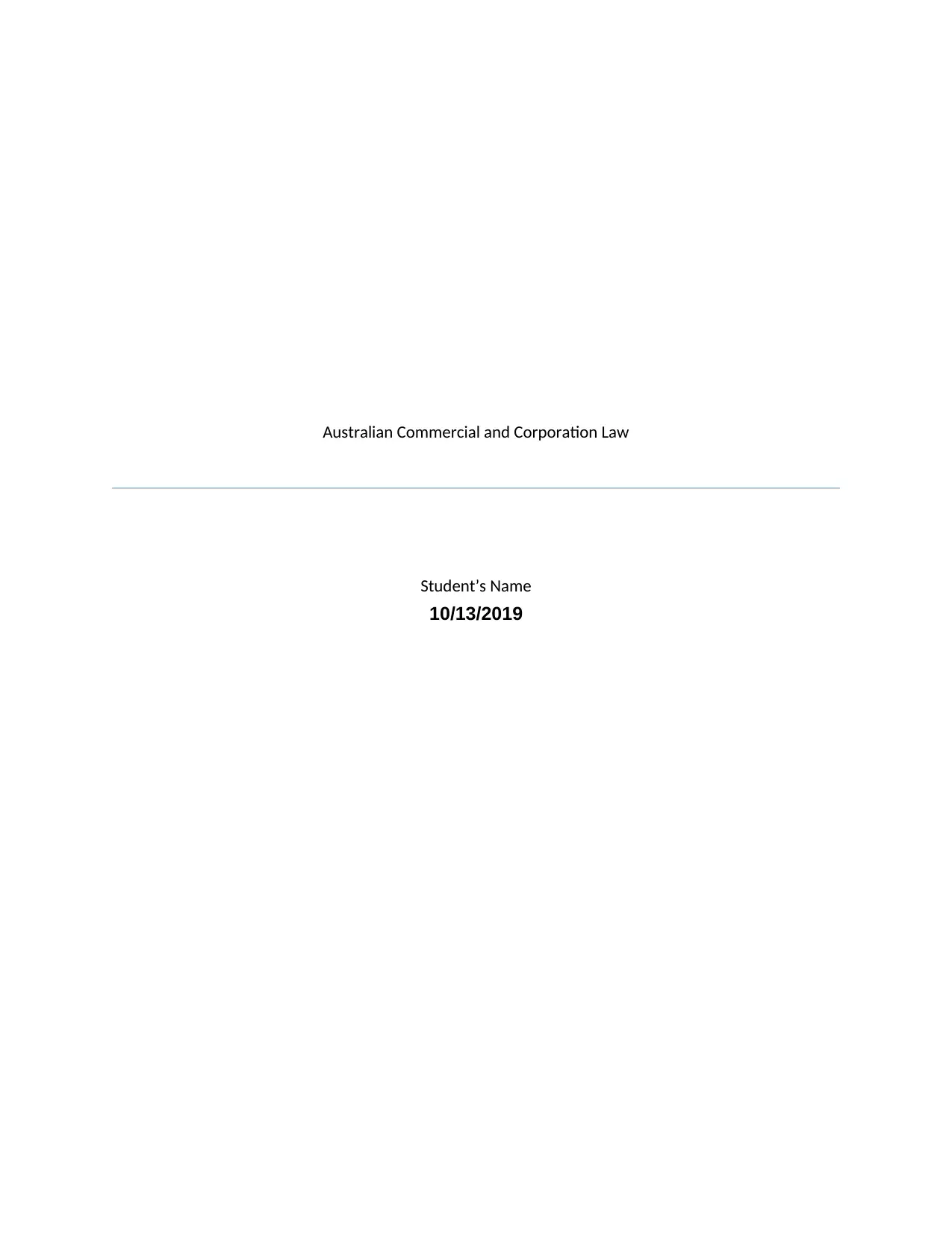
Australian Commercial and Corporation Law
Student’s Name
10/13/2019
Student’s Name
10/13/2019
Paraphrase This Document
Need a fresh take? Get an instant paraphrase of this document with our AI Paraphraser
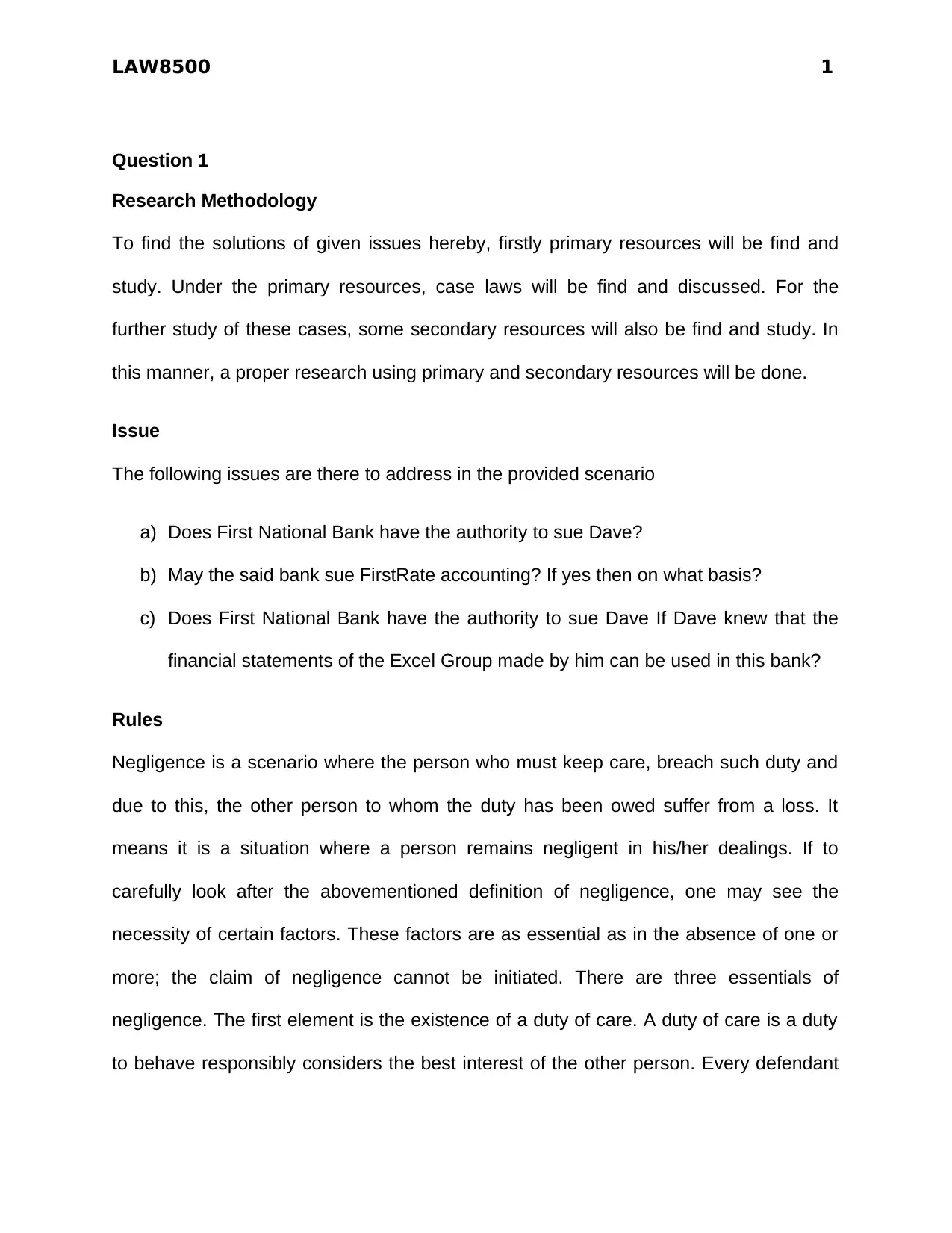
LAW8500 1
Question 1
Research Methodology
To find the solutions of given issues hereby, firstly primary resources will be find and
study. Under the primary resources, case laws will be find and discussed. For the
further study of these cases, some secondary resources will also be find and study. In
this manner, a proper research using primary and secondary resources will be done.
Issue
The following issues are there to address in the provided scenario
a) Does First National Bank have the authority to sue Dave?
b) May the said bank sue FirstRate accounting? If yes then on what basis?
c) Does First National Bank have the authority to sue Dave If Dave knew that the
financial statements of the Excel Group made by him can be used in this bank?
Rules
Negligence is a scenario where the person who must keep care, breach such duty and
due to this, the other person to whom the duty has been owed suffer from a loss. It
means it is a situation where a person remains negligent in his/her dealings. If to
carefully look after the abovementioned definition of negligence, one may see the
necessity of certain factors. These factors are as essential as in the absence of one or
more; the claim of negligence cannot be initiated. There are three essentials of
negligence. The first element is the existence of a duty of care. A duty of care is a duty
to behave responsibly considers the best interest of the other person. Every defendant
Question 1
Research Methodology
To find the solutions of given issues hereby, firstly primary resources will be find and
study. Under the primary resources, case laws will be find and discussed. For the
further study of these cases, some secondary resources will also be find and study. In
this manner, a proper research using primary and secondary resources will be done.
Issue
The following issues are there to address in the provided scenario
a) Does First National Bank have the authority to sue Dave?
b) May the said bank sue FirstRate accounting? If yes then on what basis?
c) Does First National Bank have the authority to sue Dave If Dave knew that the
financial statements of the Excel Group made by him can be used in this bank?
Rules
Negligence is a scenario where the person who must keep care, breach such duty and
due to this, the other person to whom the duty has been owed suffer from a loss. It
means it is a situation where a person remains negligent in his/her dealings. If to
carefully look after the abovementioned definition of negligence, one may see the
necessity of certain factors. These factors are as essential as in the absence of one or
more; the claim of negligence cannot be initiated. There are three essentials of
negligence. The first element is the existence of a duty of care. A duty of care is a duty
to behave responsibly considers the best interest of the other person. Every defendant
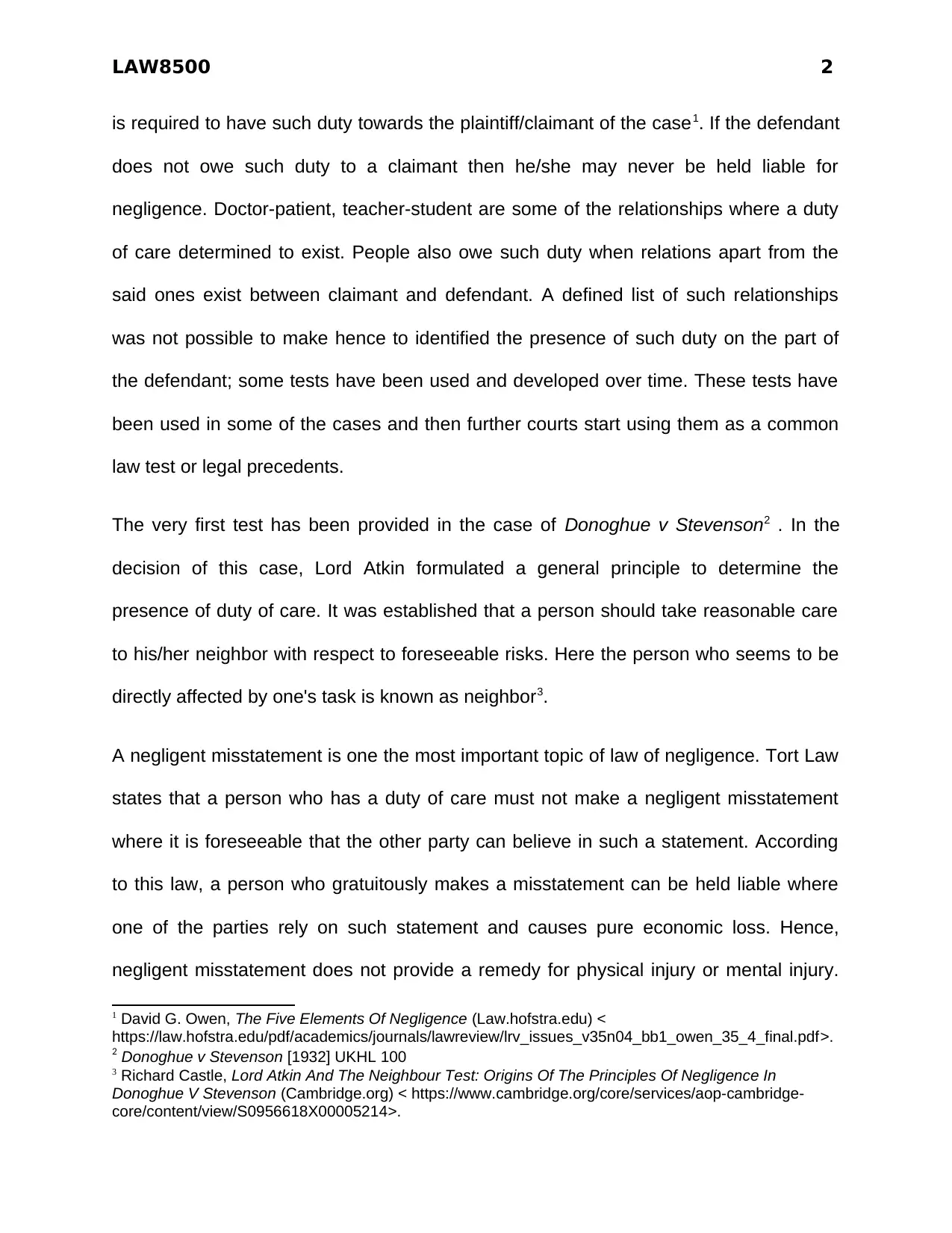
LAW8500 2
is required to have such duty towards the plaintiff/claimant of the case1. If the defendant
does not owe such duty to a claimant then he/she may never be held liable for
negligence. Doctor-patient, teacher-student are some of the relationships where a duty
of care determined to exist. People also owe such duty when relations apart from the
said ones exist between claimant and defendant. A defined list of such relationships
was not possible to make hence to identified the presence of such duty on the part of
the defendant; some tests have been used and developed over time. These tests have
been used in some of the cases and then further courts start using them as a common
law test or legal precedents.
The very first test has been provided in the case of Donoghue v Stevenson2 . In the
decision of this case, Lord Atkin formulated a general principle to determine the
presence of duty of care. It was established that a person should take reasonable care
to his/her neighbor with respect to foreseeable risks. Here the person who seems to be
directly affected by one's task is known as neighbor3.
A negligent misstatement is one the most important topic of law of negligence. Tort Law
states that a person who has a duty of care must not make a negligent misstatement
where it is foreseeable that the other party can believe in such a statement. According
to this law, a person who gratuitously makes a misstatement can be held liable where
one of the parties rely on such statement and causes pure economic loss. Hence,
negligent misstatement does not provide a remedy for physical injury or mental injury.
1 David G. Owen, The Five Elements Of Negligence (Law.hofstra.edu) <
https://law.hofstra.edu/pdf/academics/journals/lawreview/lrv_issues_v35n04_bb1_owen_35_4_final.pdf>.
2 Donoghue v Stevenson [1932] UKHL 100
3 Richard Castle, Lord Atkin And The Neighbour Test: Origins Of The Principles Of Negligence In
Donoghue V Stevenson (Cambridge.org) < https://www.cambridge.org/core/services/aop-cambridge-
core/content/view/S0956618X00005214>.
is required to have such duty towards the plaintiff/claimant of the case1. If the defendant
does not owe such duty to a claimant then he/she may never be held liable for
negligence. Doctor-patient, teacher-student are some of the relationships where a duty
of care determined to exist. People also owe such duty when relations apart from the
said ones exist between claimant and defendant. A defined list of such relationships
was not possible to make hence to identified the presence of such duty on the part of
the defendant; some tests have been used and developed over time. These tests have
been used in some of the cases and then further courts start using them as a common
law test or legal precedents.
The very first test has been provided in the case of Donoghue v Stevenson2 . In the
decision of this case, Lord Atkin formulated a general principle to determine the
presence of duty of care. It was established that a person should take reasonable care
to his/her neighbor with respect to foreseeable risks. Here the person who seems to be
directly affected by one's task is known as neighbor3.
A negligent misstatement is one the most important topic of law of negligence. Tort Law
states that a person who has a duty of care must not make a negligent misstatement
where it is foreseeable that the other party can believe in such a statement. According
to this law, a person who gratuitously makes a misstatement can be held liable where
one of the parties rely on such statement and causes pure economic loss. Hence,
negligent misstatement does not provide a remedy for physical injury or mental injury.
1 David G. Owen, The Five Elements Of Negligence (Law.hofstra.edu) <
https://law.hofstra.edu/pdf/academics/journals/lawreview/lrv_issues_v35n04_bb1_owen_35_4_final.pdf>.
2 Donoghue v Stevenson [1932] UKHL 100
3 Richard Castle, Lord Atkin And The Neighbour Test: Origins Of The Principles Of Negligence In
Donoghue V Stevenson (Cambridge.org) < https://www.cambridge.org/core/services/aop-cambridge-
core/content/view/S0956618X00005214>.
⊘ This is a preview!⊘
Do you want full access?
Subscribe today to unlock all pages.

Trusted by 1+ million students worldwide
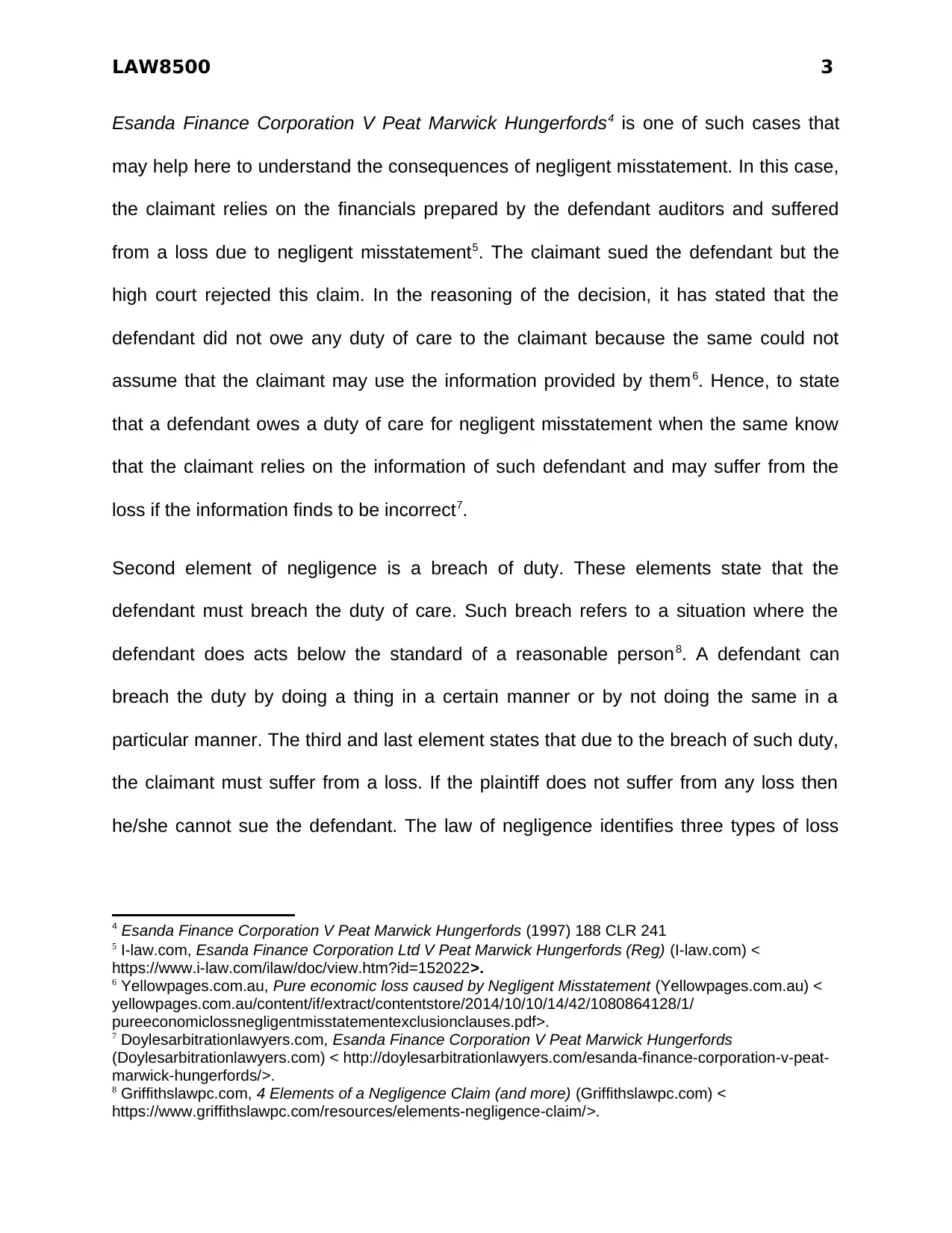
LAW8500 3
Esanda Finance Corporation V Peat Marwick Hungerfords4 is one of such cases that
may help here to understand the consequences of negligent misstatement. In this case,
the claimant relies on the financials prepared by the defendant auditors and suffered
from a loss due to negligent misstatement5. The claimant sued the defendant but the
high court rejected this claim. In the reasoning of the decision, it has stated that the
defendant did not owe any duty of care to the claimant because the same could not
assume that the claimant may use the information provided by them6. Hence, to state
that a defendant owes a duty of care for negligent misstatement when the same know
that the claimant relies on the information of such defendant and may suffer from the
loss if the information finds to be incorrect7.
Second element of negligence is a breach of duty. These elements state that the
defendant must breach the duty of care. Such breach refers to a situation where the
defendant does acts below the standard of a reasonable person8. A defendant can
breach the duty by doing a thing in a certain manner or by not doing the same in a
particular manner. The third and last element states that due to the breach of such duty,
the claimant must suffer from a loss. If the plaintiff does not suffer from any loss then
he/she cannot sue the defendant. The law of negligence identifies three types of loss
4 Esanda Finance Corporation V Peat Marwick Hungerfords (1997) 188 CLR 241
5 I-law.com, Esanda Finance Corporation Ltd V Peat Marwick Hungerfords (Reg) (I-law.com) <
https://www.i-law.com/ilaw/doc/view.htm?id=152022>.
6 Yellowpages.com.au, Pure economic loss caused by Negligent Misstatement (Yellowpages.com.au) <
yellowpages.com.au/content/if/extract/contentstore/2014/10/10/14/42/1080864128/1/
pureeconomiclossnegligentmisstatementexclusionclauses.pdf>.
7 Doylesarbitrationlawyers.com, Esanda Finance Corporation V Peat Marwick Hungerfords
(Doylesarbitrationlawyers.com) < http://doylesarbitrationlawyers.com/esanda-finance-corporation-v-peat-
marwick-hungerfords/>.
8 Griffithslawpc.com, 4 Elements of a Negligence Claim (and more) (Griffithslawpc.com) <
https://www.griffithslawpc.com/resources/elements-negligence-claim/>.
Esanda Finance Corporation V Peat Marwick Hungerfords4 is one of such cases that
may help here to understand the consequences of negligent misstatement. In this case,
the claimant relies on the financials prepared by the defendant auditors and suffered
from a loss due to negligent misstatement5. The claimant sued the defendant but the
high court rejected this claim. In the reasoning of the decision, it has stated that the
defendant did not owe any duty of care to the claimant because the same could not
assume that the claimant may use the information provided by them6. Hence, to state
that a defendant owes a duty of care for negligent misstatement when the same know
that the claimant relies on the information of such defendant and may suffer from the
loss if the information finds to be incorrect7.
Second element of negligence is a breach of duty. These elements state that the
defendant must breach the duty of care. Such breach refers to a situation where the
defendant does acts below the standard of a reasonable person8. A defendant can
breach the duty by doing a thing in a certain manner or by not doing the same in a
particular manner. The third and last element states that due to the breach of such duty,
the claimant must suffer from a loss. If the plaintiff does not suffer from any loss then
he/she cannot sue the defendant. The law of negligence identifies three types of loss
4 Esanda Finance Corporation V Peat Marwick Hungerfords (1997) 188 CLR 241
5 I-law.com, Esanda Finance Corporation Ltd V Peat Marwick Hungerfords (Reg) (I-law.com) <
https://www.i-law.com/ilaw/doc/view.htm?id=152022>.
6 Yellowpages.com.au, Pure economic loss caused by Negligent Misstatement (Yellowpages.com.au) <
yellowpages.com.au/content/if/extract/contentstore/2014/10/10/14/42/1080864128/1/
pureeconomiclossnegligentmisstatementexclusionclauses.pdf>.
7 Doylesarbitrationlawyers.com, Esanda Finance Corporation V Peat Marwick Hungerfords
(Doylesarbitrationlawyers.com) < http://doylesarbitrationlawyers.com/esanda-finance-corporation-v-peat-
marwick-hungerfords/>.
8 Griffithslawpc.com, 4 Elements of a Negligence Claim (and more) (Griffithslawpc.com) <
https://www.griffithslawpc.com/resources/elements-negligence-claim/>.
Paraphrase This Document
Need a fresh take? Get an instant paraphrase of this document with our AI Paraphraser
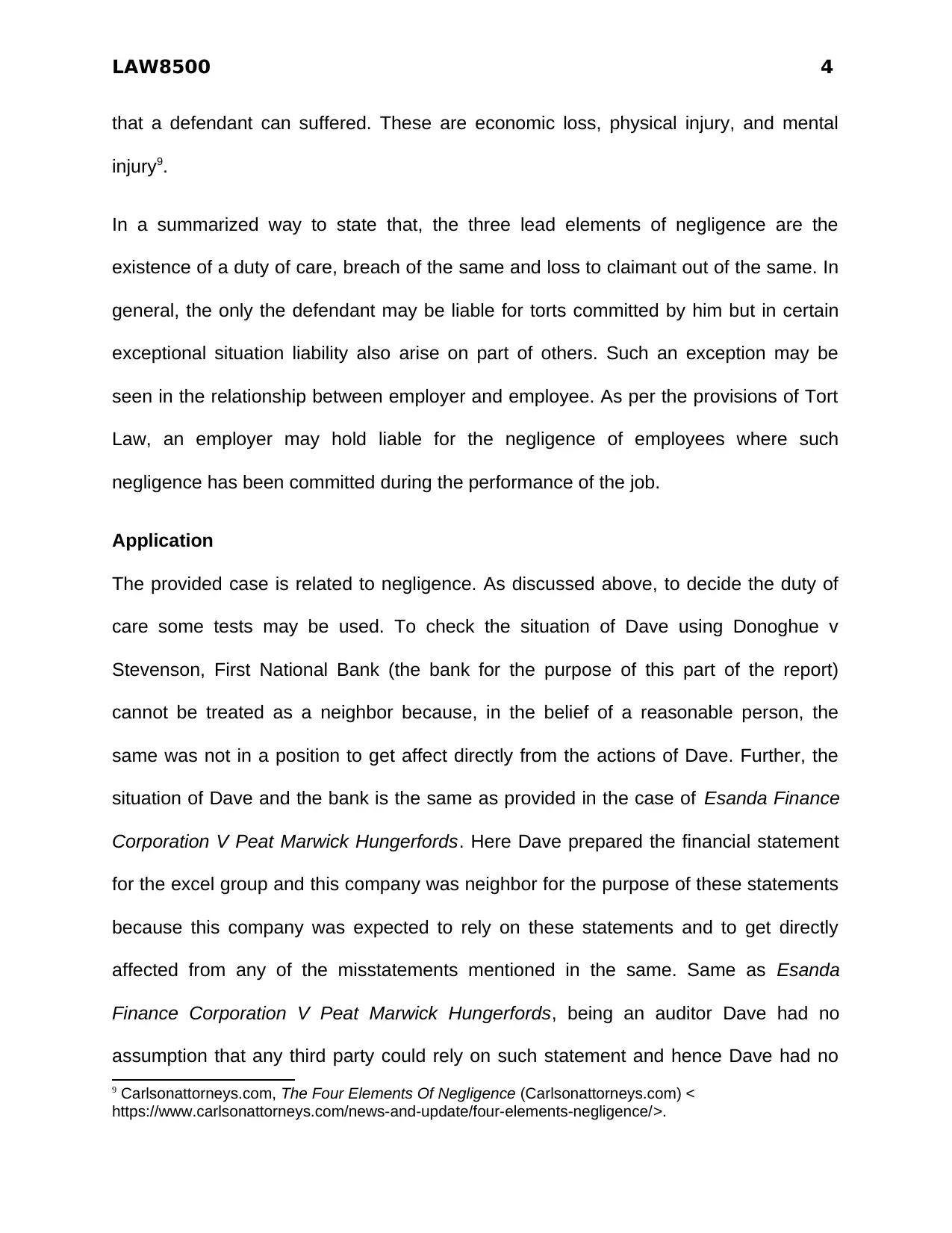
LAW8500 4
that a defendant can suffered. These are economic loss, physical injury, and mental
injury9.
In a summarized way to state that, the three lead elements of negligence are the
existence of a duty of care, breach of the same and loss to claimant out of the same. In
general, the only the defendant may be liable for torts committed by him but in certain
exceptional situation liability also arise on part of others. Such an exception may be
seen in the relationship between employer and employee. As per the provisions of Tort
Law, an employer may hold liable for the negligence of employees where such
negligence has been committed during the performance of the job.
Application
The provided case is related to negligence. As discussed above, to decide the duty of
care some tests may be used. To check the situation of Dave using Donoghue v
Stevenson, First National Bank (the bank for the purpose of this part of the report)
cannot be treated as a neighbor because, in the belief of a reasonable person, the
same was not in a position to get affect directly from the actions of Dave. Further, the
situation of Dave and the bank is the same as provided in the case of Esanda Finance
Corporation V Peat Marwick Hungerfords. Here Dave prepared the financial statement
for the excel group and this company was neighbor for the purpose of these statements
because this company was expected to rely on these statements and to get directly
affected from any of the misstatements mentioned in the same. Same as Esanda
Finance Corporation V Peat Marwick Hungerfords, being an auditor Dave had no
assumption that any third party could rely on such statement and hence Dave had no
9 Carlsonattorneys.com, The Four Elements Of Negligence (Carlsonattorneys.com) <
https://www.carlsonattorneys.com/news-and-update/four-elements-negligence/>.
that a defendant can suffered. These are economic loss, physical injury, and mental
injury9.
In a summarized way to state that, the three lead elements of negligence are the
existence of a duty of care, breach of the same and loss to claimant out of the same. In
general, the only the defendant may be liable for torts committed by him but in certain
exceptional situation liability also arise on part of others. Such an exception may be
seen in the relationship between employer and employee. As per the provisions of Tort
Law, an employer may hold liable for the negligence of employees where such
negligence has been committed during the performance of the job.
Application
The provided case is related to negligence. As discussed above, to decide the duty of
care some tests may be used. To check the situation of Dave using Donoghue v
Stevenson, First National Bank (the bank for the purpose of this part of the report)
cannot be treated as a neighbor because, in the belief of a reasonable person, the
same was not in a position to get affect directly from the actions of Dave. Further, the
situation of Dave and the bank is the same as provided in the case of Esanda Finance
Corporation V Peat Marwick Hungerfords. Here Dave prepared the financial statement
for the excel group and this company was neighbor for the purpose of these statements
because this company was expected to rely on these statements and to get directly
affected from any of the misstatements mentioned in the same. Same as Esanda
Finance Corporation V Peat Marwick Hungerfords, being an auditor Dave had no
assumption that any third party could rely on such statement and hence Dave had no
9 Carlsonattorneys.com, The Four Elements Of Negligence (Carlsonattorneys.com) <
https://www.carlsonattorneys.com/news-and-update/four-elements-negligence/>.
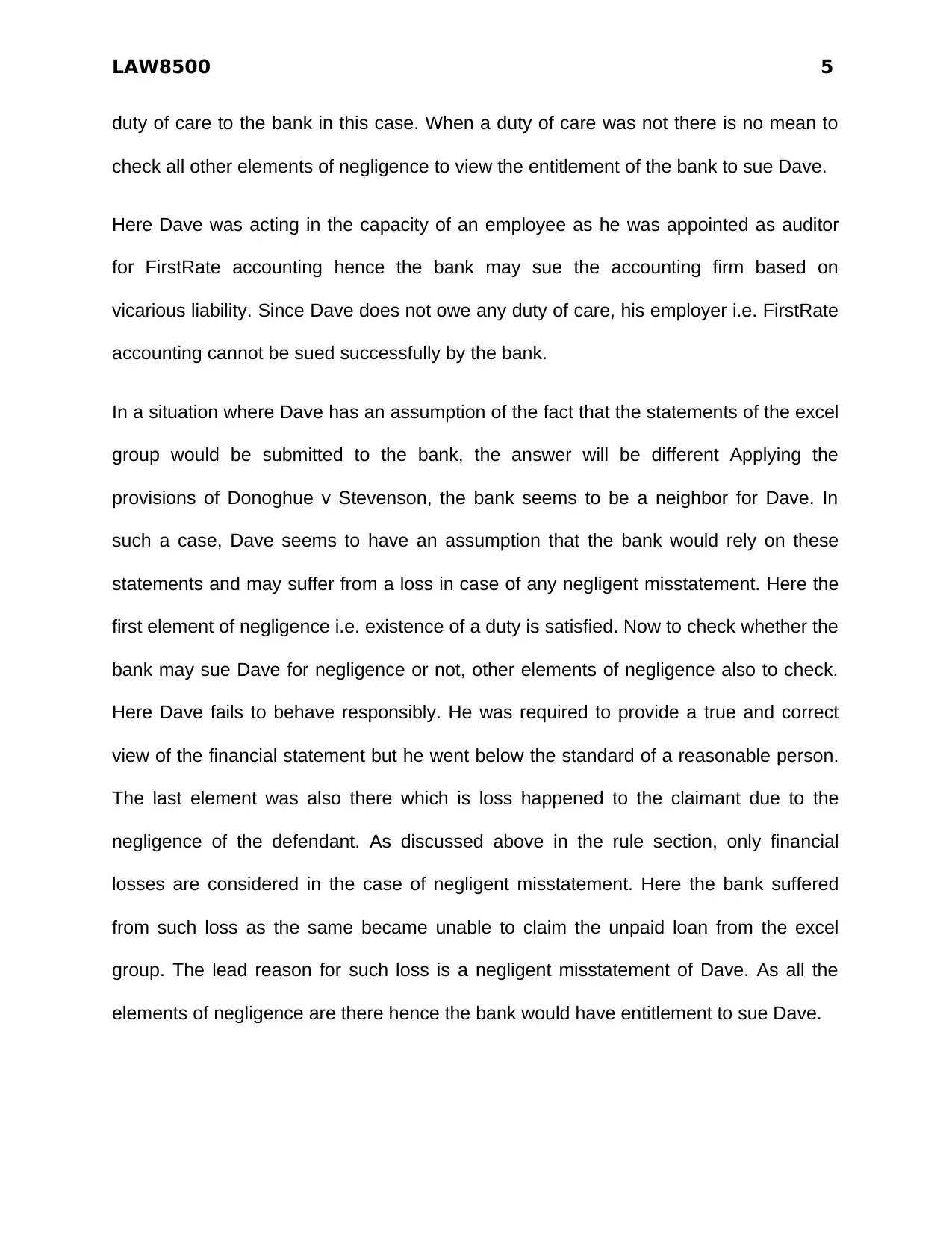
LAW8500 5
duty of care to the bank in this case. When a duty of care was not there is no mean to
check all other elements of negligence to view the entitlement of the bank to sue Dave.
Here Dave was acting in the capacity of an employee as he was appointed as auditor
for FirstRate accounting hence the bank may sue the accounting firm based on
vicarious liability. Since Dave does not owe any duty of care, his employer i.e. FirstRate
accounting cannot be sued successfully by the bank.
In a situation where Dave has an assumption of the fact that the statements of the excel
group would be submitted to the bank, the answer will be different Applying the
provisions of Donoghue v Stevenson, the bank seems to be a neighbor for Dave. In
such a case, Dave seems to have an assumption that the bank would rely on these
statements and may suffer from a loss in case of any negligent misstatement. Here the
first element of negligence i.e. existence of a duty is satisfied. Now to check whether the
bank may sue Dave for negligence or not, other elements of negligence also to check.
Here Dave fails to behave responsibly. He was required to provide a true and correct
view of the financial statement but he went below the standard of a reasonable person.
The last element was also there which is loss happened to the claimant due to the
negligence of the defendant. As discussed above in the rule section, only financial
losses are considered in the case of negligent misstatement. Here the bank suffered
from such loss as the same became unable to claim the unpaid loan from the excel
group. The lead reason for such loss is a negligent misstatement of Dave. As all the
elements of negligence are there hence the bank would have entitlement to sue Dave.
duty of care to the bank in this case. When a duty of care was not there is no mean to
check all other elements of negligence to view the entitlement of the bank to sue Dave.
Here Dave was acting in the capacity of an employee as he was appointed as auditor
for FirstRate accounting hence the bank may sue the accounting firm based on
vicarious liability. Since Dave does not owe any duty of care, his employer i.e. FirstRate
accounting cannot be sued successfully by the bank.
In a situation where Dave has an assumption of the fact that the statements of the excel
group would be submitted to the bank, the answer will be different Applying the
provisions of Donoghue v Stevenson, the bank seems to be a neighbor for Dave. In
such a case, Dave seems to have an assumption that the bank would rely on these
statements and may suffer from a loss in case of any negligent misstatement. Here the
first element of negligence i.e. existence of a duty is satisfied. Now to check whether the
bank may sue Dave for negligence or not, other elements of negligence also to check.
Here Dave fails to behave responsibly. He was required to provide a true and correct
view of the financial statement but he went below the standard of a reasonable person.
The last element was also there which is loss happened to the claimant due to the
negligence of the defendant. As discussed above in the rule section, only financial
losses are considered in the case of negligent misstatement. Here the bank suffered
from such loss as the same became unable to claim the unpaid loan from the excel
group. The lead reason for such loss is a negligent misstatement of Dave. As all the
elements of negligence are there hence the bank would have entitlement to sue Dave.
⊘ This is a preview!⊘
Do you want full access?
Subscribe today to unlock all pages.

Trusted by 1+ million students worldwide
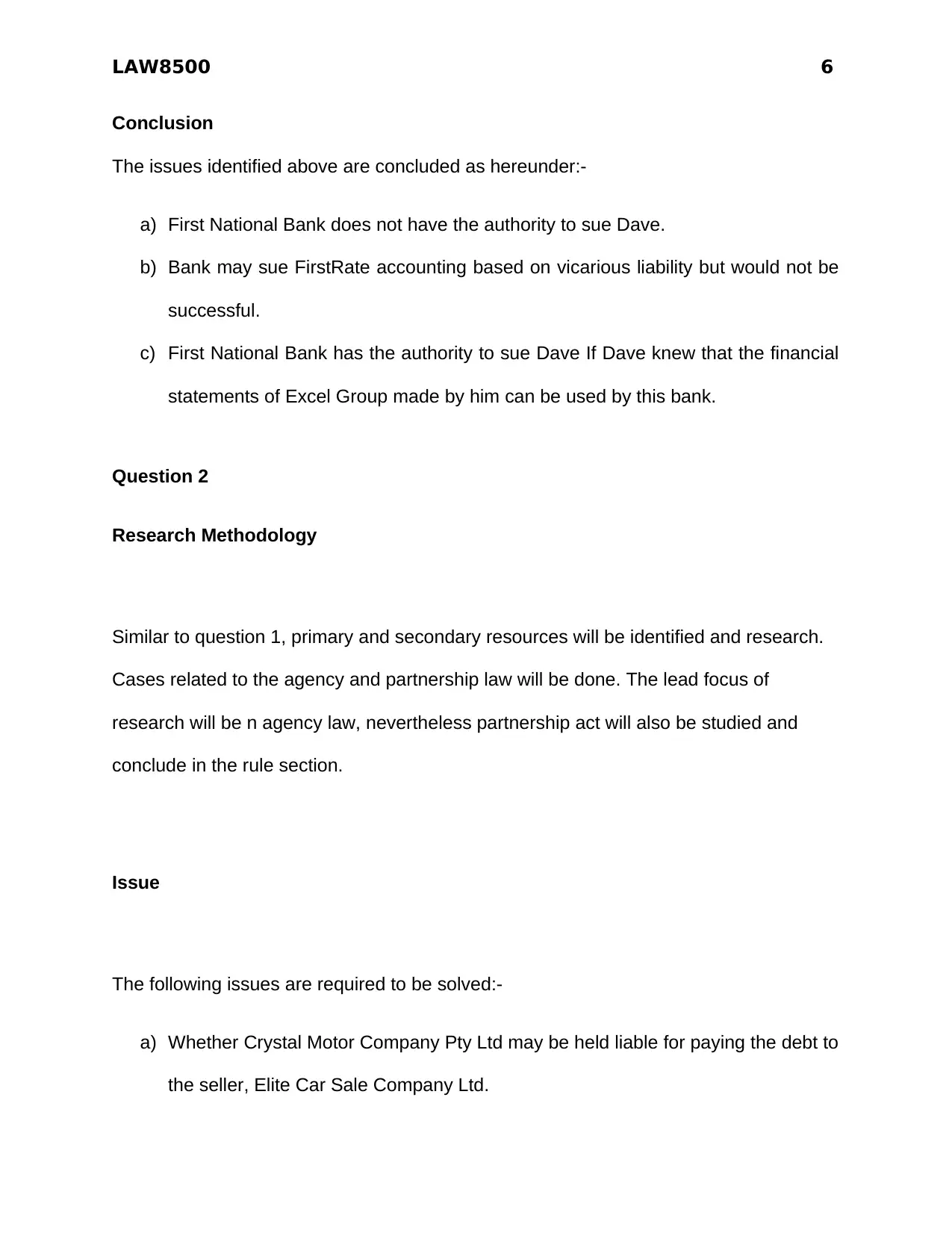
LAW8500 6
Conclusion
The issues identified above are concluded as hereunder:-
a) First National Bank does not have the authority to sue Dave.
b) Bank may sue FirstRate accounting based on vicarious liability but would not be
successful.
c) First National Bank has the authority to sue Dave If Dave knew that the financial
statements of Excel Group made by him can be used by this bank.
Question 2
Research Methodology
Similar to question 1, primary and secondary resources will be identified and research.
Cases related to the agency and partnership law will be done. The lead focus of
research will be n agency law, nevertheless partnership act will also be studied and
conclude in the rule section.
Issue
The following issues are required to be solved:-
a) Whether Crystal Motor Company Pty Ltd may be held liable for paying the debt to
the seller, Elite Car Sale Company Ltd.
Conclusion
The issues identified above are concluded as hereunder:-
a) First National Bank does not have the authority to sue Dave.
b) Bank may sue FirstRate accounting based on vicarious liability but would not be
successful.
c) First National Bank has the authority to sue Dave If Dave knew that the financial
statements of Excel Group made by him can be used by this bank.
Question 2
Research Methodology
Similar to question 1, primary and secondary resources will be identified and research.
Cases related to the agency and partnership law will be done. The lead focus of
research will be n agency law, nevertheless partnership act will also be studied and
conclude in the rule section.
Issue
The following issues are required to be solved:-
a) Whether Crystal Motor Company Pty Ltd may be held liable for paying the debt to
the seller, Elite Car Sale Company Ltd.
Paraphrase This Document
Need a fresh take? Get an instant paraphrase of this document with our AI Paraphraser
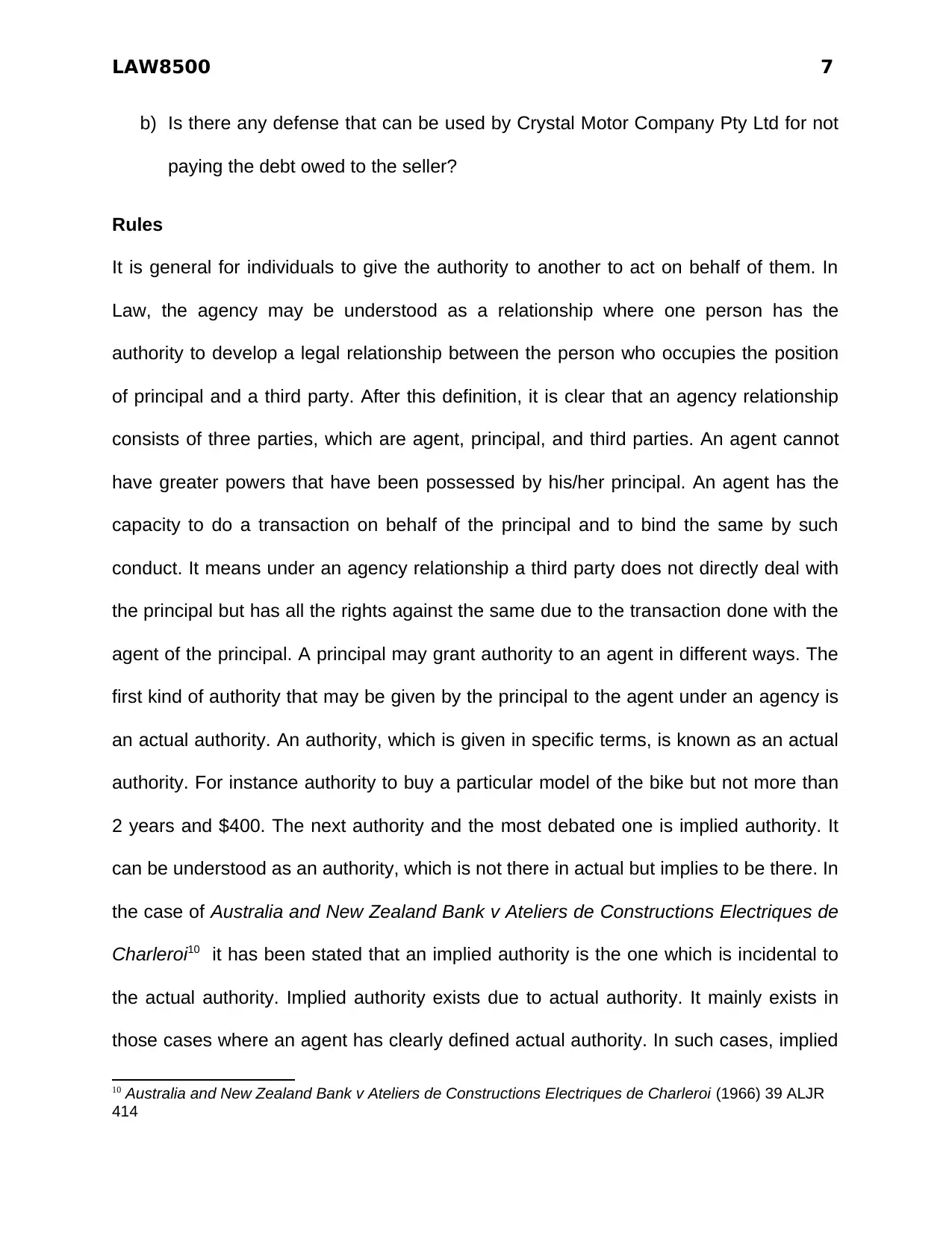
LAW8500 7
b) Is there any defense that can be used by Crystal Motor Company Pty Ltd for not
paying the debt owed to the seller?
Rules
It is general for individuals to give the authority to another to act on behalf of them. In
Law, the agency may be understood as a relationship where one person has the
authority to develop a legal relationship between the person who occupies the position
of principal and a third party. After this definition, it is clear that an agency relationship
consists of three parties, which are agent, principal, and third parties. An agent cannot
have greater powers that have been possessed by his/her principal. An agent has the
capacity to do a transaction on behalf of the principal and to bind the same by such
conduct. It means under an agency relationship a third party does not directly deal with
the principal but has all the rights against the same due to the transaction done with the
agent of the principal. A principal may grant authority to an agent in different ways. The
first kind of authority that may be given by the principal to the agent under an agency is
an actual authority. An authority, which is given in specific terms, is known as an actual
authority. For instance authority to buy a particular model of the bike but not more than
2 years and $400. The next authority and the most debated one is implied authority. It
can be understood as an authority, which is not there in actual but implies to be there. In
the case of Australia and New Zealand Bank v Ateliers de Constructions Electriques de
Charleroi10 it has been stated that an implied authority is the one which is incidental to
the actual authority. Implied authority exists due to actual authority. It mainly exists in
those cases where an agent has clearly defined actual authority. In such cases, implied
10 Australia and New Zealand Bank v Ateliers de Constructions Electriques de Charleroi (1966) 39 ALJR
414
b) Is there any defense that can be used by Crystal Motor Company Pty Ltd for not
paying the debt owed to the seller?
Rules
It is general for individuals to give the authority to another to act on behalf of them. In
Law, the agency may be understood as a relationship where one person has the
authority to develop a legal relationship between the person who occupies the position
of principal and a third party. After this definition, it is clear that an agency relationship
consists of three parties, which are agent, principal, and third parties. An agent cannot
have greater powers that have been possessed by his/her principal. An agent has the
capacity to do a transaction on behalf of the principal and to bind the same by such
conduct. It means under an agency relationship a third party does not directly deal with
the principal but has all the rights against the same due to the transaction done with the
agent of the principal. A principal may grant authority to an agent in different ways. The
first kind of authority that may be given by the principal to the agent under an agency is
an actual authority. An authority, which is given in specific terms, is known as an actual
authority. For instance authority to buy a particular model of the bike but not more than
2 years and $400. The next authority and the most debated one is implied authority. It
can be understood as an authority, which is not there in actual but implies to be there. In
the case of Australia and New Zealand Bank v Ateliers de Constructions Electriques de
Charleroi10 it has been stated that an implied authority is the one which is incidental to
the actual authority. Implied authority exists due to actual authority. It mainly exists in
those cases where an agent has clearly defined actual authority. In such cases, implied
10 Australia and New Zealand Bank v Ateliers de Constructions Electriques de Charleroi (1966) 39 ALJR
414
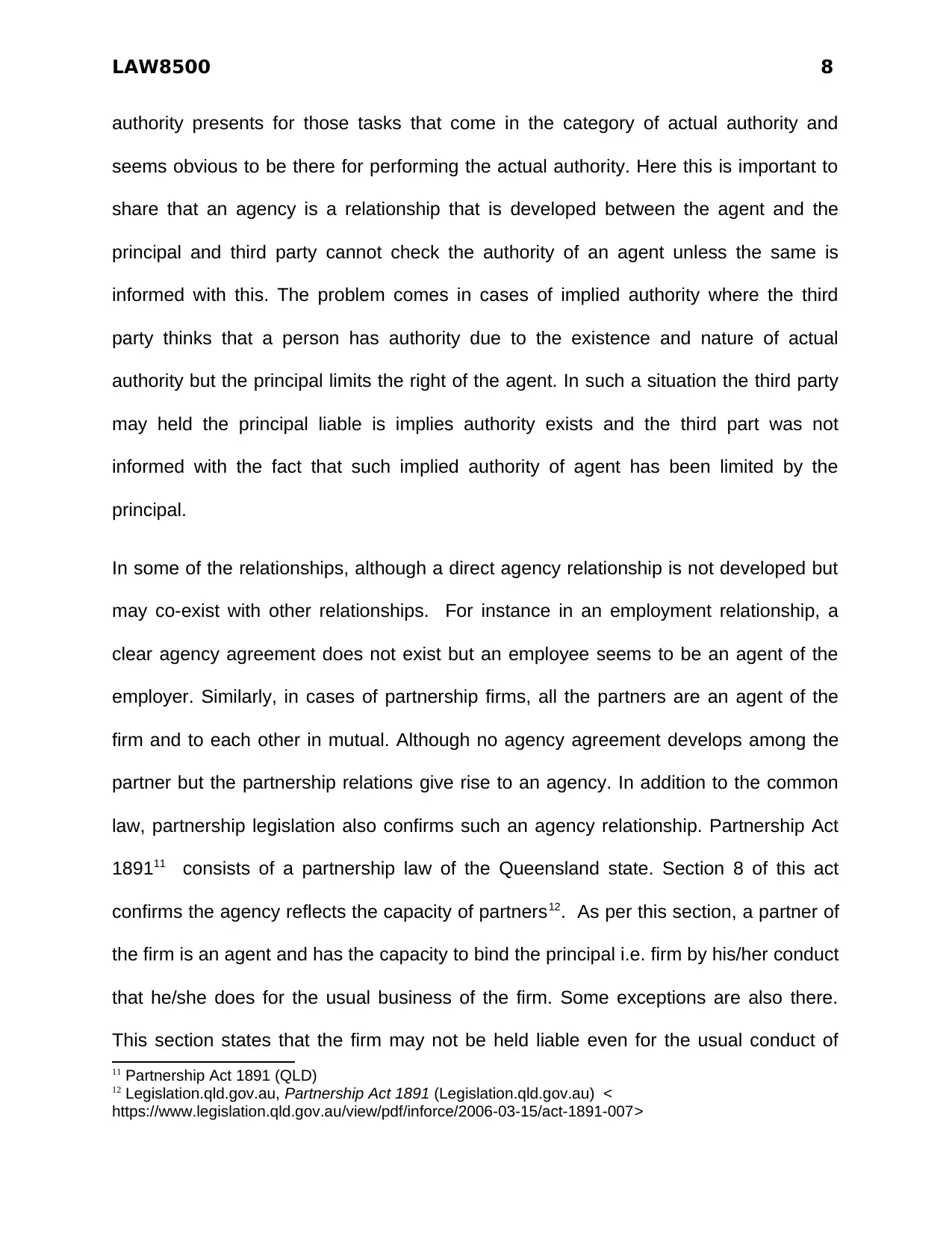
LAW8500 8
authority presents for those tasks that come in the category of actual authority and
seems obvious to be there for performing the actual authority. Here this is important to
share that an agency is a relationship that is developed between the agent and the
principal and third party cannot check the authority of an agent unless the same is
informed with this. The problem comes in cases of implied authority where the third
party thinks that a person has authority due to the existence and nature of actual
authority but the principal limits the right of the agent. In such a situation the third party
may held the principal liable is implies authority exists and the third part was not
informed with the fact that such implied authority of agent has been limited by the
principal.
In some of the relationships, although a direct agency relationship is not developed but
may co-exist with other relationships. For instance in an employment relationship, a
clear agency agreement does not exist but an employee seems to be an agent of the
employer. Similarly, in cases of partnership firms, all the partners are an agent of the
firm and to each other in mutual. Although no agency agreement develops among the
partner but the partnership relations give rise to an agency. In addition to the common
law, partnership legislation also confirms such an agency relationship. Partnership Act
189111 consists of a partnership law of the Queensland state. Section 8 of this act
confirms the agency reflects the capacity of partners12. As per this section, a partner of
the firm is an agent and has the capacity to bind the principal i.e. firm by his/her conduct
that he/she does for the usual business of the firm. Some exceptions are also there.
This section states that the firm may not be held liable even for the usual conduct of
11 Partnership Act 1891 (QLD)
12 Legislation.qld.gov.au, Partnership Act 1891 (Legislation.qld.gov.au) <
https://www.legislation.qld.gov.au/view/pdf/inforce/2006-03-15/act-1891-007>
authority presents for those tasks that come in the category of actual authority and
seems obvious to be there for performing the actual authority. Here this is important to
share that an agency is a relationship that is developed between the agent and the
principal and third party cannot check the authority of an agent unless the same is
informed with this. The problem comes in cases of implied authority where the third
party thinks that a person has authority due to the existence and nature of actual
authority but the principal limits the right of the agent. In such a situation the third party
may held the principal liable is implies authority exists and the third part was not
informed with the fact that such implied authority of agent has been limited by the
principal.
In some of the relationships, although a direct agency relationship is not developed but
may co-exist with other relationships. For instance in an employment relationship, a
clear agency agreement does not exist but an employee seems to be an agent of the
employer. Similarly, in cases of partnership firms, all the partners are an agent of the
firm and to each other in mutual. Although no agency agreement develops among the
partner but the partnership relations give rise to an agency. In addition to the common
law, partnership legislation also confirms such an agency relationship. Partnership Act
189111 consists of a partnership law of the Queensland state. Section 8 of this act
confirms the agency reflects the capacity of partners12. As per this section, a partner of
the firm is an agent and has the capacity to bind the principal i.e. firm by his/her conduct
that he/she does for the usual business of the firm. Some exceptions are also there.
This section states that the firm may not be held liable even for the usual conduct of
11 Partnership Act 1891 (QLD)
12 Legislation.qld.gov.au, Partnership Act 1891 (Legislation.qld.gov.au) <
https://www.legislation.qld.gov.au/view/pdf/inforce/2006-03-15/act-1891-007>
⊘ This is a preview!⊘
Do you want full access?
Subscribe today to unlock all pages.

Trusted by 1+ million students worldwide
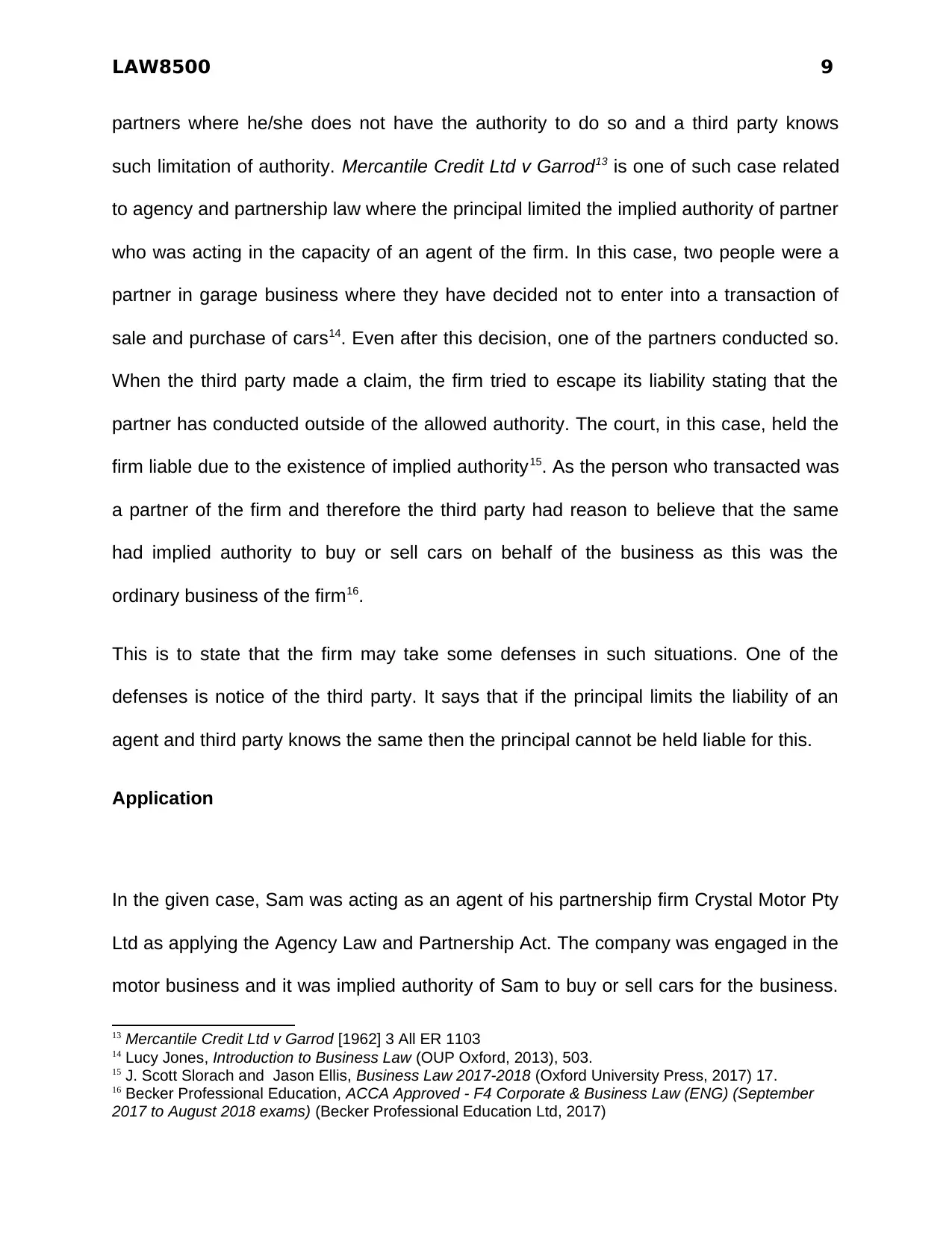
LAW8500 9
partners where he/she does not have the authority to do so and a third party knows
such limitation of authority. Mercantile Credit Ltd v Garrod13 is one of such case related
to agency and partnership law where the principal limited the implied authority of partner
who was acting in the capacity of an agent of the firm. In this case, two people were a
partner in garage business where they have decided not to enter into a transaction of
sale and purchase of cars14. Even after this decision, one of the partners conducted so.
When the third party made a claim, the firm tried to escape its liability stating that the
partner has conducted outside of the allowed authority. The court, in this case, held the
firm liable due to the existence of implied authority15. As the person who transacted was
a partner of the firm and therefore the third party had reason to believe that the same
had implied authority to buy or sell cars on behalf of the business as this was the
ordinary business of the firm16.
This is to state that the firm may take some defenses in such situations. One of the
defenses is notice of the third party. It says that if the principal limits the liability of an
agent and third party knows the same then the principal cannot be held liable for this.
Application
In the given case, Sam was acting as an agent of his partnership firm Crystal Motor Pty
Ltd as applying the Agency Law and Partnership Act. The company was engaged in the
motor business and it was implied authority of Sam to buy or sell cars for the business.
13 Mercantile Credit Ltd v Garrod [1962] 3 All ER 1103
14 Lucy Jones, Introduction to Business Law (OUP Oxford, 2013), 503.
15 J. Scott Slorach and Jason Ellis, Business Law 2017-2018 (Oxford University Press, 2017) 17.
16 Becker Professional Education, ACCA Approved - F4 Corporate & Business Law (ENG) (September
2017 to August 2018 exams) (Becker Professional Education Ltd, 2017)
partners where he/she does not have the authority to do so and a third party knows
such limitation of authority. Mercantile Credit Ltd v Garrod13 is one of such case related
to agency and partnership law where the principal limited the implied authority of partner
who was acting in the capacity of an agent of the firm. In this case, two people were a
partner in garage business where they have decided not to enter into a transaction of
sale and purchase of cars14. Even after this decision, one of the partners conducted so.
When the third party made a claim, the firm tried to escape its liability stating that the
partner has conducted outside of the allowed authority. The court, in this case, held the
firm liable due to the existence of implied authority15. As the person who transacted was
a partner of the firm and therefore the third party had reason to believe that the same
had implied authority to buy or sell cars on behalf of the business as this was the
ordinary business of the firm16.
This is to state that the firm may take some defenses in such situations. One of the
defenses is notice of the third party. It says that if the principal limits the liability of an
agent and third party knows the same then the principal cannot be held liable for this.
Application
In the given case, Sam was acting as an agent of his partnership firm Crystal Motor Pty
Ltd as applying the Agency Law and Partnership Act. The company was engaged in the
motor business and it was implied authority of Sam to buy or sell cars for the business.
13 Mercantile Credit Ltd v Garrod [1962] 3 All ER 1103
14 Lucy Jones, Introduction to Business Law (OUP Oxford, 2013), 503.
15 J. Scott Slorach and Jason Ellis, Business Law 2017-2018 (Oxford University Press, 2017) 17.
16 Becker Professional Education, ACCA Approved - F4 Corporate & Business Law (ENG) (September
2017 to August 2018 exams) (Becker Professional Education Ltd, 2017)
Paraphrase This Document
Need a fresh take? Get an instant paraphrase of this document with our AI Paraphraser
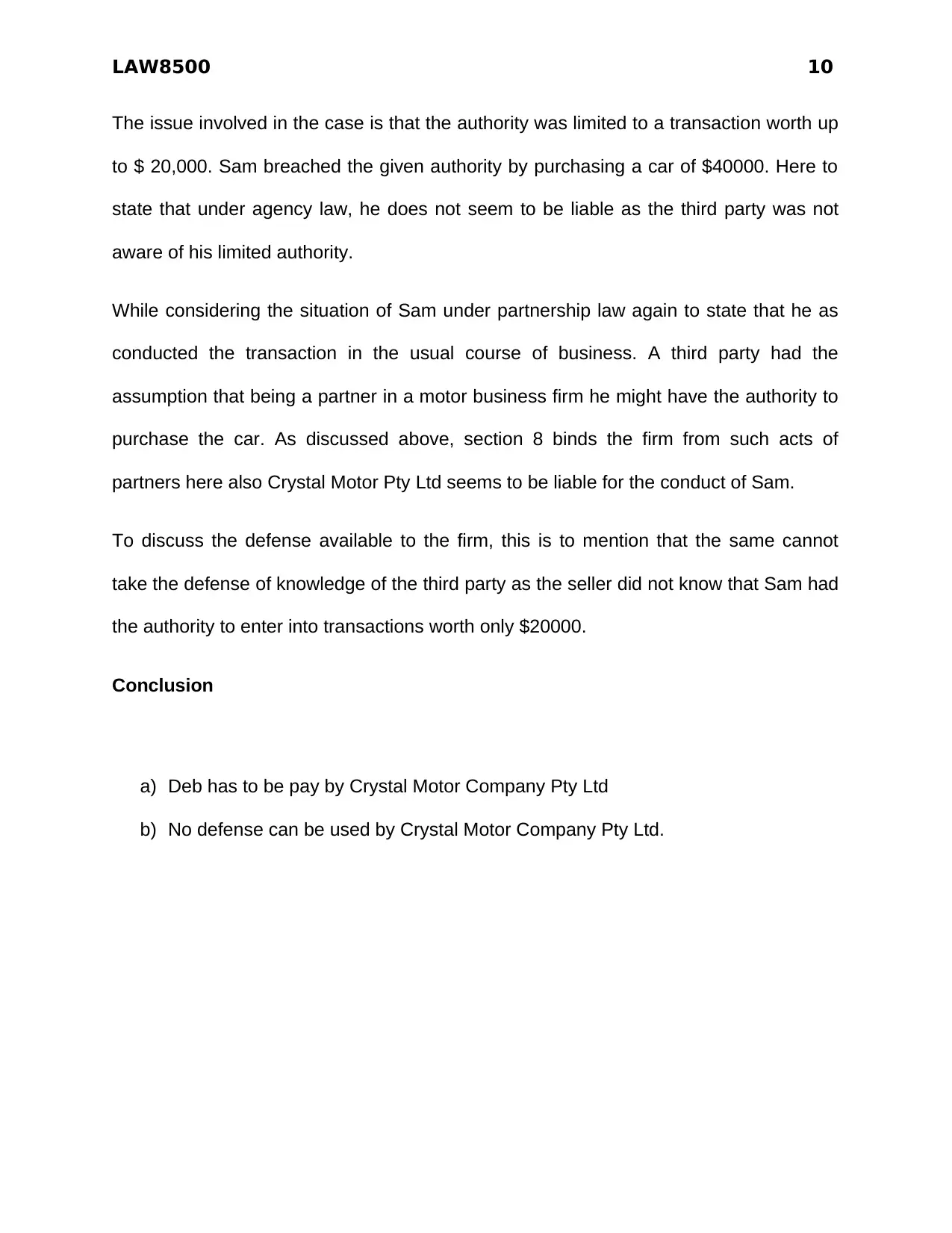
LAW8500 10
The issue involved in the case is that the authority was limited to a transaction worth up
to $ 20,000. Sam breached the given authority by purchasing a car of $40000. Here to
state that under agency law, he does not seem to be liable as the third party was not
aware of his limited authority.
While considering the situation of Sam under partnership law again to state that he as
conducted the transaction in the usual course of business. A third party had the
assumption that being a partner in a motor business firm he might have the authority to
purchase the car. As discussed above, section 8 binds the firm from such acts of
partners here also Crystal Motor Pty Ltd seems to be liable for the conduct of Sam.
To discuss the defense available to the firm, this is to mention that the same cannot
take the defense of knowledge of the third party as the seller did not know that Sam had
the authority to enter into transactions worth only $20000.
Conclusion
a) Deb has to be pay by Crystal Motor Company Pty Ltd
b) No defense can be used by Crystal Motor Company Pty Ltd.
The issue involved in the case is that the authority was limited to a transaction worth up
to $ 20,000. Sam breached the given authority by purchasing a car of $40000. Here to
state that under agency law, he does not seem to be liable as the third party was not
aware of his limited authority.
While considering the situation of Sam under partnership law again to state that he as
conducted the transaction in the usual course of business. A third party had the
assumption that being a partner in a motor business firm he might have the authority to
purchase the car. As discussed above, section 8 binds the firm from such acts of
partners here also Crystal Motor Pty Ltd seems to be liable for the conduct of Sam.
To discuss the defense available to the firm, this is to mention that the same cannot
take the defense of knowledge of the third party as the seller did not know that Sam had
the authority to enter into transactions worth only $20000.
Conclusion
a) Deb has to be pay by Crystal Motor Company Pty Ltd
b) No defense can be used by Crystal Motor Company Pty Ltd.
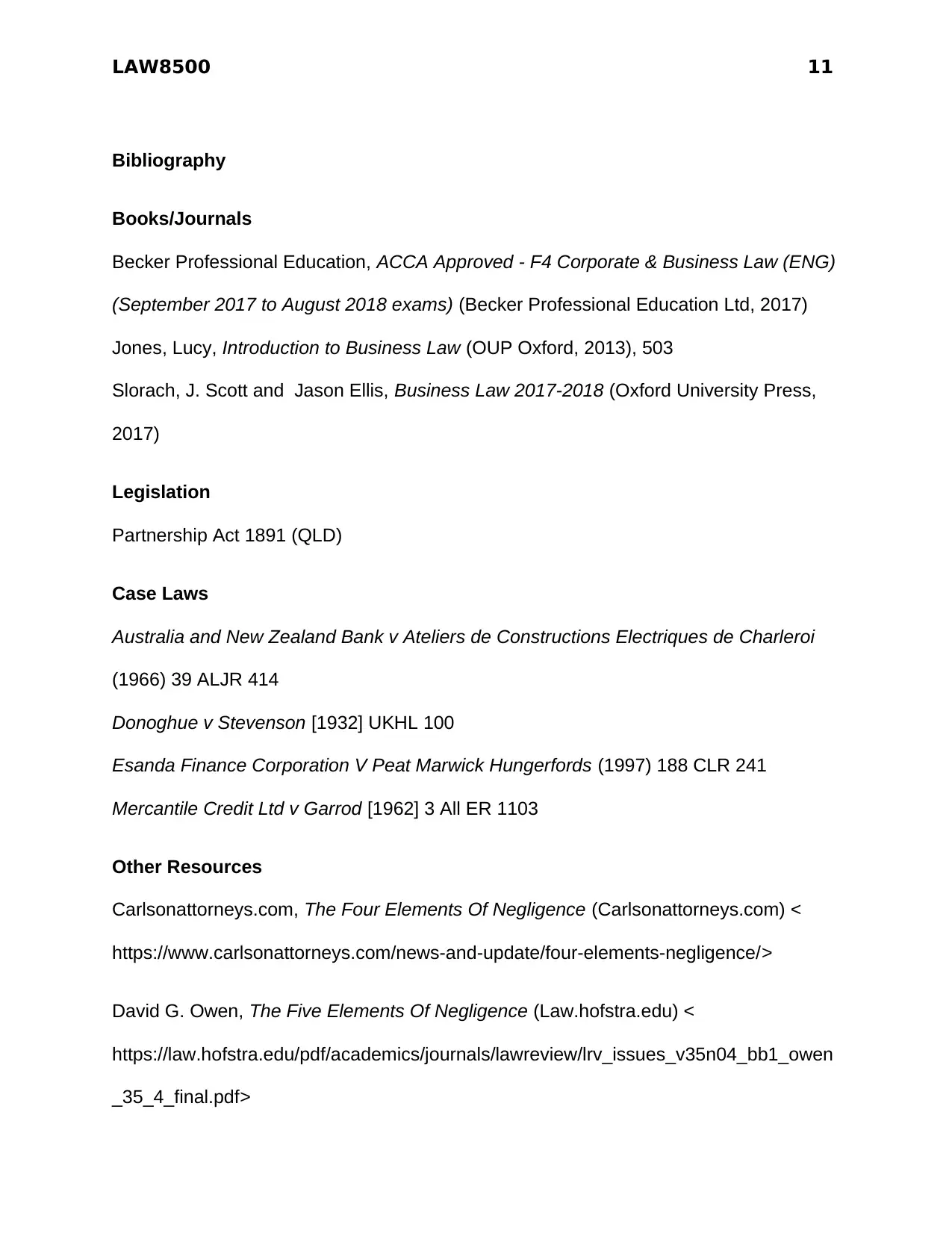
LAW8500 11
Bibliography
Books/Journals
Becker Professional Education, ACCA Approved - F4 Corporate & Business Law (ENG)
(September 2017 to August 2018 exams) (Becker Professional Education Ltd, 2017)
Jones, Lucy, Introduction to Business Law (OUP Oxford, 2013), 503
Slorach, J. Scott and Jason Ellis, Business Law 2017-2018 (Oxford University Press,
2017)
Legislation
Partnership Act 1891 (QLD)
Case Laws
Australia and New Zealand Bank v Ateliers de Constructions Electriques de Charleroi
(1966) 39 ALJR 414
Donoghue v Stevenson [1932] UKHL 100
Esanda Finance Corporation V Peat Marwick Hungerfords (1997) 188 CLR 241
Mercantile Credit Ltd v Garrod [1962] 3 All ER 1103
Other Resources
Carlsonattorneys.com, The Four Elements Of Negligence (Carlsonattorneys.com) <
https://www.carlsonattorneys.com/news-and-update/four-elements-negligence/>
David G. Owen, The Five Elements Of Negligence (Law.hofstra.edu) <
https://law.hofstra.edu/pdf/academics/journals/lawreview/lrv_issues_v35n04_bb1_owen
_35_4_final.pdf>
Bibliography
Books/Journals
Becker Professional Education, ACCA Approved - F4 Corporate & Business Law (ENG)
(September 2017 to August 2018 exams) (Becker Professional Education Ltd, 2017)
Jones, Lucy, Introduction to Business Law (OUP Oxford, 2013), 503
Slorach, J. Scott and Jason Ellis, Business Law 2017-2018 (Oxford University Press,
2017)
Legislation
Partnership Act 1891 (QLD)
Case Laws
Australia and New Zealand Bank v Ateliers de Constructions Electriques de Charleroi
(1966) 39 ALJR 414
Donoghue v Stevenson [1932] UKHL 100
Esanda Finance Corporation V Peat Marwick Hungerfords (1997) 188 CLR 241
Mercantile Credit Ltd v Garrod [1962] 3 All ER 1103
Other Resources
Carlsonattorneys.com, The Four Elements Of Negligence (Carlsonattorneys.com) <
https://www.carlsonattorneys.com/news-and-update/four-elements-negligence/>
David G. Owen, The Five Elements Of Negligence (Law.hofstra.edu) <
https://law.hofstra.edu/pdf/academics/journals/lawreview/lrv_issues_v35n04_bb1_owen
_35_4_final.pdf>
⊘ This is a preview!⊘
Do you want full access?
Subscribe today to unlock all pages.

Trusted by 1+ million students worldwide
1 out of 13
Related Documents
Your All-in-One AI-Powered Toolkit for Academic Success.
+13062052269
info@desklib.com
Available 24*7 on WhatsApp / Email
![[object Object]](/_next/static/media/star-bottom.7253800d.svg)
Unlock your academic potential
Copyright © 2020–2025 A2Z Services. All Rights Reserved. Developed and managed by ZUCOL.





